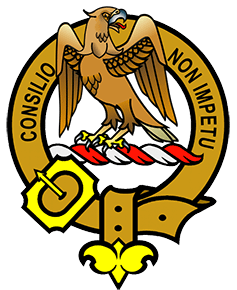Agnew Clan
Agnew Crest: An eagle, issuing, regardant, proper.
Agnew Clan Motto: Consilio Non Impetu (By wisdom, not by rashness).
Agnew Clan History:
A family of Norman origin from the Baronie d'Agneaux in Northern France, who first appeared in Scotland at Liddesdale in the 12th century, and from the 14th century were settled in Wigtownshire and Galloway.
An alternate origin is credited to the O'Gnies of Ulster, hereditary bards of the Clannaboy O'Neills, who anglicised their name to Agnew. Although this would give the Agnews a common ancestry with Clan Donald and Clan
Macdougall, there is no confirmation of the claim and the Norman descent is thought to be more plausible.
In 1426, Andrew Agnew was appointed Constable of Lochnaw Castle and, in 1451, was confirmed as Hereditary Sheriff of Wigtownshire. From the marriage of his second son to a daughter of the Macdowall Chief descend the Lochryan Agnews. The course of the 15th century saw the decline of the powerful House of Douglas, which greatly benefited the Agnews of Galloway.
In 1629, Sir Patrick Agnew, 8th Sheriff of Lochnaw and a member of the Scottish Parliament for Wigtownshire was created a Baronet of Nova Scotia. On his death in 1661, his eldest son Andrew succeeded him both as Sheriff and in the parliament, and married Lady Anne Stewart, a daughter of the 1st Earl of Galloway. Sir James Agnew, 4th Baronet, married Lady Mary Montgomerie, a daughter of the 8th Earl of Eglinton, fought at the Battle of Dettingen in 1743, and fathered twenty-one children. In 1746, he was responsible for holding Blair Castle against the Jacobite army of Prince Charles Edward Stuart. Mary Agnew, one of Sir James' granddaughters married Lord Braxfield, the celebrated "hanging judge."
Located in the south-west of Scotland, it was inevitable that the Agnews should retain close links with Ulster across the North Channel of the Irish Sea and, in 1792, Andrew Agnew, son of Sir Stair Agnew, 6th Baronet, married Martha de Courcy, daughter of the 26th Lord Kingsale. His son, also Andrew, was born posthumously and inherited as 7th Baronet. Around this time, a large number of Irish Agnews emigrated to Pennsylvania in America. Today, there are members of the Agnew Association based in America, Canada, Brazil and Australia.
Sir Crispin Agnew of Lochnaw, QC, 11th Baronet and the current Chief, holds the office of Rothesay Herald at the Court of the Lord Lyon King of Arms and was responsible for designing the Agnew clan tartan. A Major in the Royal Highland Fusiliers, he has taken part in expeditions to Everest, Greenland, Antarctica and Patagonia,
In the 1930s, Lochnaw Castle, at Leswalt in Wigtownshire, which dates from the 15th century, was purchased by Miss Del Agnew from Australia. Her forebear Sir James Wilson Agnew (1815-1901), was born in Ireland, educated in Glasgow and emigrated to Australia, then to Tasmania where he was elected President from 1886 to 1887.
Places of Interest: Lochnaw Castle, Leswalt, Wigtownshire. King David II appointed the Agnews keepers of the original castle in 1363. The building was captured and demolished by Archibald the Grim, Earl of Douglas in the late 1300's. The Agnews built a new tower house nearby in the early 1400's. The property was sold by the family in 1997 and is now in private ownership. There is a particularly striking portrait by the American artist John Singer Sargent of Lady Agnew of Lochnaw, wife of Sir Andrew Agnew of Lochnaw, 9th Baronet, which hangs in the National Gallery of Scotland. Cruggleton Castle, nr. Garlieston, Wigtownshire. 13th-century castle which was secured by the Agnews of Lochnaw in the 1600's. Galdenoch Castle, nr. Leswalt, Wigtownshire. Tower House contstructed by Gilbert Agnew of Lochnaw in the mid-1500's.
Name distribution in Scotland: Most instances of the Agnew surname occur in Ayrshire, Dumfries and Galloway (Dumfriesshire, Kirkcudbrightshire and Wigtownshire) and North and South Lanarkshire.

